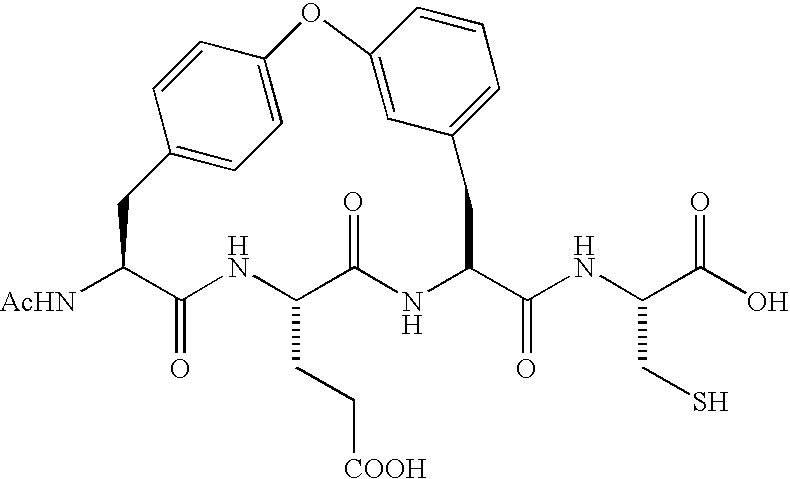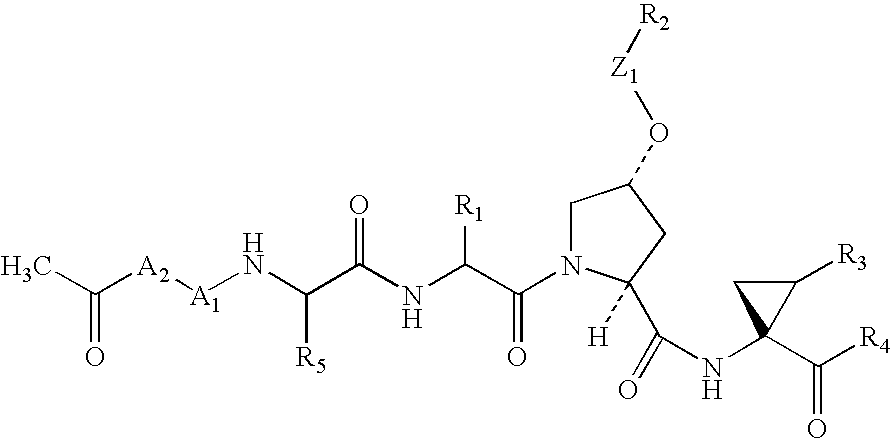Inhibitors of hepatitis C virus NS3/NS4a serine protease
a protease inhibitor and hepatitis c virus technology, applied in the direction of dipeptides, drug compositions, peptide ingredients, etc., can solve the problems of low sustained response rate of therapies, frequent side effects, and poor treatment effect of patients with hcv infection
- Summary
- Abstract
- Description
- Claims
- Application Information
AI Technical Summary
Benefits of technology
Problems solved by technology
Method used
Image
Examples
example 1
PREPARATIVE EXAMPLE 1
[0208]
[0209]
[0210]A solution of pyrazinecarboxylic acid 1a (3 g) in 150 mL of dry dichloromethane and 150 mL of dry DMF was stirred at 0° C. and treated with HATU (1.4 eq, 6.03 g). L-cyclohexylglycine hydrochloride 1b (1.2 eq, 6.03 g) was added in small portions. Then, N-methylmorpholine (4 eq, 10 mL, d 0.920) was added dropwise. The reaction mixture was gradually warmed to room temperature and stirred for 20 h. All the volatiles were removed under vacuum and the residue was dissolved in 500 mL of ethyl acetate. The organic layer was washed with water (100 mL), aqueous 1 N HCl (100 mL), aqueous saturated sodium bicarbonate solution (100 mL), and brine (100 mL). The organic layer was dried over magnesium sulfate, filtered and concentrated under reduced pressure. The residue was chromatographed on silica gel (gradient: acetone / hexanes; 5:95 to 3:7) to afford the product as a white solid.
[0211]
[0212]A solution of the methyl ester 1c (6.5 g) in 270 mL of a 1:1:1 mix...
example 2
PREPARATIVE EXAMPLE 2
[0236]
[0237]
[0238]To a solution of 4-pentyn-1-ol, 2a (4.15 g; Aldrich) was added Dess-Martin periodinane (30.25 g; Aldrich) and the resulting mixture was stirred for 45 min. before the addition of (tert-Butoxycarbonylmethylene)triphenylphosphorane (26.75 g; Aldrich). The resulting dark reaction was stirred overnight, diluted with ethyl acetate), washed with aqueous sodium sulfite, saturated aqueous sodium bicarbonate, water, brine and dried. The volatiles were removed under reduced pressure and the residue was purified by silica gel column chromatography using 1% ethyl acetate in hexanes as eluent to give the desired compound 2b (3.92 g). Some impure fractions were also obtained but set aside at this time.
[0239]
[0240]Using the alkene 2b (1.9 g) in n-propanol (20 mL; Aldrich)), benzyl carbamate (4.95 g; Aldrich) in n-propanol (40 mL), NaOH (1.29 g) in water (79 ml), tert-butyl hypochlorite (3.7 ml), (DHQ)2PHAL (0.423 g; Aldrich)) in n-propanol (37.5 ml), and pota...
example 3
PREPARATIVE EXAMPLE 3
[0251]
[0252]
[0253]The N-Boc protected amine 3a (3 g) was dissolved in 60 mL of 4M HCl solution in dioxanes. The mixture was stirred at room temperature until all the starting material had been consumed as determined by TLC (ethyl acetate / hexanes; 6:4). After 2 h, all the volatiles were removed under reduced pressure to afford the product 3b (2.4 g, 98%) as a white solid which was used without further purification.
[0254]
[0255]A solution of acid 1j (150 mg) in 3 mL of dry dichloromethane and 3 mL of dry DMF was stirred at 0° C. and treated with HATU (1.4 eq, 155 mg). The amine hydrochloride 3b (88 mg) was added followed by N-methylmorpholine (4 eq, 0.13 mL, d 0.920). The reaction mixture was stirred overnight (temp 0 to 25° C.). All the volatiles were removed under vacuum and the residue was dissolved in 50 mL of ethyl acetate. The organic layer was washed with water (10 mL), aqueous 1N HCl (10 mL), aqueous saturated sodium bicarbonate solution (10 mL), and brine ...
PUM
| Property | Measurement | Unit |
|---|---|---|
| volume | aaaaa | aaaaa |
| temperature | aaaaa | aaaaa |
| pH | aaaaa | aaaaa |
Abstract
Description
Claims
Application Information
 Login to View More
Login to View More - R&D
- Intellectual Property
- Life Sciences
- Materials
- Tech Scout
- Unparalleled Data Quality
- Higher Quality Content
- 60% Fewer Hallucinations
Browse by: Latest US Patents, China's latest patents, Technical Efficacy Thesaurus, Application Domain, Technology Topic, Popular Technical Reports.
© 2025 PatSnap. All rights reserved.Legal|Privacy policy|Modern Slavery Act Transparency Statement|Sitemap|About US| Contact US: help@patsnap.com



